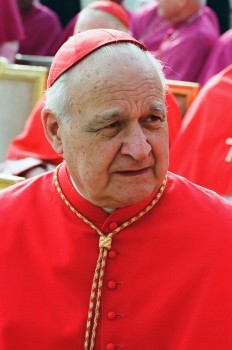Cardinal Gilberto Agustoni, Prefect emeritus of the Supreme Tribunal of Apostolic Signatura, was born in Schaffhausen, Switzerland, on 26 July 1922 into a deeply Christian family. As a civil servant, his father, who came from Ticino, moved to eastern Switzerland for work reasons. His mother on the other hand, came from a village on the shores of Lake Constance.
He had four brothers and one sister. Two of his brothers have died, and two are priests; his sister lives in Switzerland with her family.
Cardinal Agustoni completed his compulsory education in his native town. However, since he wanted to become a priest he was taken to the Diocesan seminary of Lugano as his father wanted him to follow in the footsteps of his brother Luigi who had already entered this seminary a few years earlier.
When he had finished his secondary school education, he was sent to Rome to start theology.
He did a preparatory year at St Thomas' University and obtained a degree in philosophy, but the events of war caused Bishop Angelo Jelmini of Lugano to keep his student in Switzerland and have him continue his studies at the University of Fribourg where, in fact, he acquired a degree in sacred theology.
On 20 April 1946, he was ordained to the priesthood in Lugano Cathedral and the Bishop named him assistant chaplain to the diocesan Catholic Action, which at the time was firmly established and very active. He was entrusted in particular with the young people and students at the various Swiss universities. Thus during those years he was responsible above all for the formation aspect and worked out the necessary programmes for youth and for the Association of Catholic Explorers.
In 1950, Cardinal Ottaviani, then Assessor of the Congregation of the Holy Office, asked the Bishop of Lugano for the young priest Agustoni whom he had met on several occasions. On the senior Prelate's persistence, the Bishop finally gave in, although not without regret.
Agustoni started to work for the Holy See on 1 July 1950, when Cardinal Ottaviani had obtained permission from the Pope to take on a priest who was not yet 30 in a dicastery with a particularly serious and sensitive role, especially before its reform after the Second Vatican Council.
This was also the reason why the Assessor, Cardinal Ottaviani, followed the young official in his Congregation closely. To complete his training in the theological sciences, he encouraged him to begin studying law at the Pontifical Lateran University, and there earned a licentiate. In the meantime, he continued his work at the dicastery until he became the head of a department.
During those years, he was also appointed commissioner at the Congregation for the Discipline of the Sacraments, dealing with matrimonial cases. Immediately after the Council, he was named consultor to the Consilium ad exsequendam Constitutionem de Sacra Liturgia, working in this capacity as a liaison between these two dicasteries which were the most deeply involved in the difficult and historical undertaking of post-conciliar liturgical renewal. He was subsequently named consultor to the Congregation for Divine Worship established by Pope Paul VI.
In May 1970, Cardinal Agustoni joined the ranks of the Ecclesiastical Magistrature as Prelate Auditor of the Tribunal of the Roman Rota, where he remained until December 1986, when the Supreme Pontiff John Paul II named him Secretary of the Congregation for the Clergy, and as such, titular Archbishop of Caprulae. The Holy Father himself ordained him Bishop the following 6 January, together with nine confrères, during the traditional episcopal ordination for the Epiphany.
Cardinal Agustoni worked at the Congregation for the Clergy at a particularly interesting period due to two events of ecclesiastical importance. In fact, the General Synod of Bishops for the Formation of Priests in the Circumstances of the Present Day was being prepared and was then celebrated in 1990. The document Pastores dabo vobis was a result.
At the same time, the Holy Father had established the Commission for Drafting the New Catechism of the Catholic Church, presided over by Cardinal Ratzinger and to which the Cardinal Prefect of the Congregation for the Clergy also belonged since the dicastery was more concerned by this subject than any other, given its institutional competence in the area of catechesis. The Congregation was thus required to collaborate specifically and it was incumbent upon the Secretary of the dicastery to co-ordinate this collaboration.
The Secretary of the Congregation for the Clergy was a member by right of the International Council for Catechesis, an office established on a par with the dicastery and which has proved a valid instrument for study and consultation in the specific area of catechesis because its members come from all the different parts of the world. This Council was given a fresh impetus, especially with a view to the publication of the new Catechism of the Church, being prepared at that time.
He also played an active part in drafting the Apostolic constitution Pastor Bonus and the Regulations of the Roman Curia which partially represents its practical application.
In May 1991, Cardinal Agustoni was named a member of the Supreme Tribunal of the Apostolic Signatura, while he continued to be Secretary of the Congregation for the Clergy.
However, scarcely a year later, in April 1992 the Holy Father appointed him Pro-Prefect of this same Supreme Tribunal, to succeed Cardinal Achille Silvestrini who had been appointed Prefect of the Congregation for the Oriental Churches.
As Pro-Prefect of the Supreme Tribunal, Cardinal Agustoni was also named Pro-President of Vatican City's Supreme Court of Appeal.
Nominated Prefect of Supreme Tribunal of Apostolic Signatura on 29 November 1994 (until October 1998).
Created and proclaimed Cardinal by St. John Paul II in the Consistory of 26 November 1994, of the Title of Santi Urbano e Lorenzo a Prima Porta (Sts. Urban and Laurence at Prima Porta), deaconry elevated pro hac vice to presbyteral title.
Cardinal Gilberto Agustoni died on January 13th, 2017.

